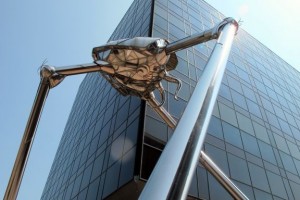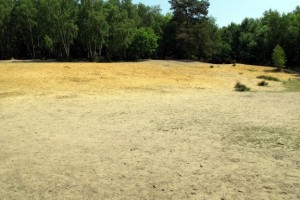Because we had business in nearby West Byfleet, and it was a lovely day, we decided to drive on afterwards to Woking for lunch and have a look at the Wellsian sites there. I take my duties as Vice-President of the H. G. Wells Society proudly and seriously, if somewhat intermittently.
 We went first to 143 Maybury Road, to which Wells had moved in June 1895. The house then was named ‘Lynton’, a small semi-detached villa opposite a railway line, but with a garden at the back. Woking has its own huge Common in Horsell, apparently visible from the top floor windows of the house, and there and in the surrounding countryside, Wells and his second wife Amy Catherine (who was known as Jane), took frequent bicycle rides. These trips were part of the inspiration for Wells’s 1896 novel, The Wheels of Chance. The photograph shows 143 Maybury Road as it is today. A commemorative blue plaque seems long overdue, because this is the house in which The War of the Worlds and The Invisible Man were written.
We went first to 143 Maybury Road, to which Wells had moved in June 1895. The house then was named ‘Lynton’, a small semi-detached villa opposite a railway line, but with a garden at the back. Woking has its own huge Common in Horsell, apparently visible from the top floor windows of the house, and there and in the surrounding countryside, Wells and his second wife Amy Catherine (who was known as Jane), took frequent bicycle rides. These trips were part of the inspiration for Wells’s 1896 novel, The Wheels of Chance. The photograph shows 143 Maybury Road as it is today. A commemorative blue plaque seems long overdue, because this is the house in which The War of the Worlds and The Invisible Man were written.
Please note that the photograph of 143 Maybury Road shown on the Woking website about H. G. Wells is incorrect. It is also incorrect on Wikipedia. The house shown on both these sites is actually no. 141, and has no Wellsian connection.
 Next, we moved to the centre of the town, where in 1998 the artist Michael Condron installed his breathtaking sculpture of the “Martian Walking Engine”. This a beautiful piece of work, not only a fine sculpture in its own right but accurate in many details to Wells’s descriptions in The War of the Worlds. It is almost the right size: Wells said the tripods were at least 60 feet high, and the sculpture is not far short of that.
Next, we moved to the centre of the town, where in 1998 the artist Michael Condron installed his breathtaking sculpture of the “Martian Walking Engine”. This a beautiful piece of work, not only a fine sculpture in its own right but accurate in many details to Wells’s descriptions in The War of the Worlds. It is almost the right size: Wells said the tripods were at least 60 feet high, and the sculpture is not far short of that.
 Close beside it is this smaller sculpture, depicting one of the Martian cylinders after its dramatic nose-first crash landing in the sandpits of Horsell Common. And speaking of which, we concluded our mini-tour of Wells memorabilia with a walk across the Common in search of the sandpit itself. It is not at all difficult to find, as there is a large map of the Common in the car park, with the main features clearly shown. Because of the long winter just finished, and the delayed spring, British trees seem incandescent with brilliant green at the moment, and the walk under the tall pine trees (with a few large young oaks growing up between them) was an inspiring and reinvigorating experience.
Close beside it is this smaller sculpture, depicting one of the Martian cylinders after its dramatic nose-first crash landing in the sandpits of Horsell Common. And speaking of which, we concluded our mini-tour of Wells memorabilia with a walk across the Common in search of the sandpit itself. It is not at all difficult to find, as there is a large map of the Common in the car park, with the main features clearly shown. Because of the long winter just finished, and the delayed spring, British trees seem incandescent with brilliant green at the moment, and the walk under the tall pine trees (with a few large young oaks growing up between them) was an inspiring and reinvigorating experience.  The sandpit itself is still much as it must have been in Wells’s days, at least before the Martians came along and ploughed everything up, and as it was a weekday we had the place almost entirely to ourselves.
The sandpit itself is still much as it must have been in Wells’s days, at least before the Martians came along and ploughed everything up, and as it was a weekday we had the place almost entirely to ourselves.
I should have noted at the beginning of this post that a spoiler for The Adjacent is contained within.